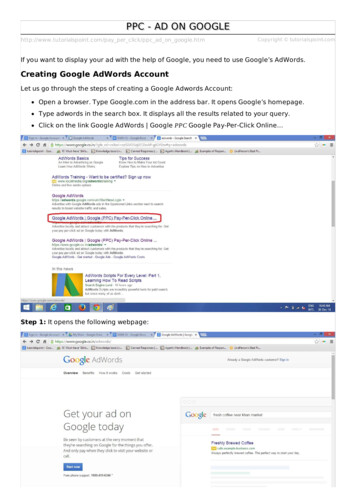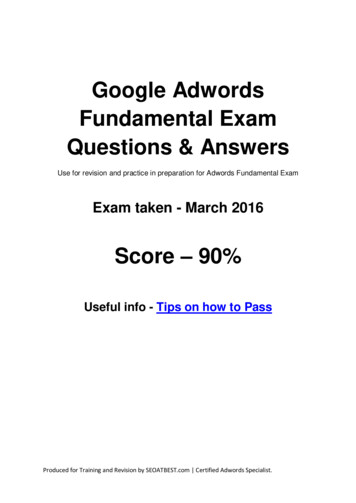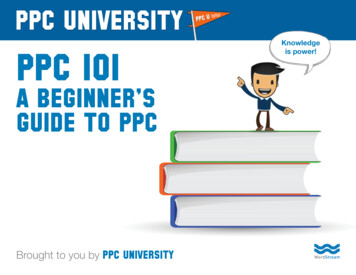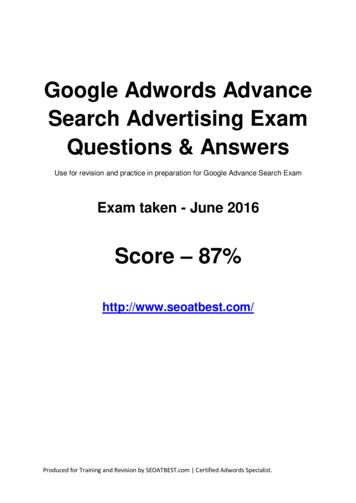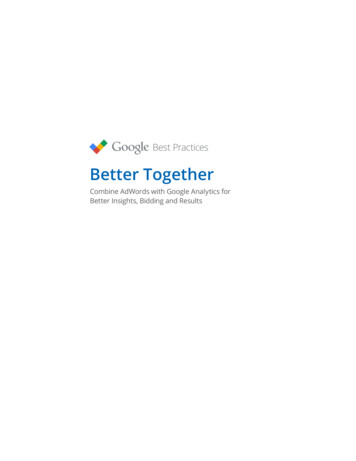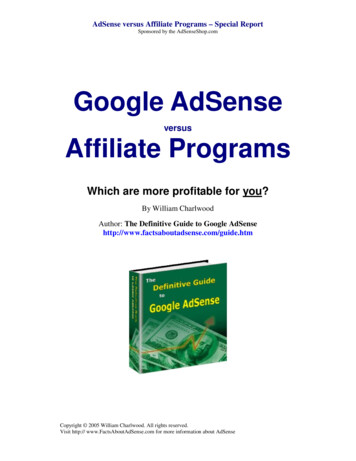
Transcription
Moving to Google AdWordsA Hands-On Guide for Premium Advertisers
After just five years in business, we’re gratified to have become the searchengine people prefer. But that doesn’t mean “mission accomplished.” Since1999, we’ve also developed search-based advertising programs. You alreadyknow our first product, Google Premium Sponsorships.In 2002 we introduced our cost-per-click (CPC) ad program, Google AdWords. Because of market response (and what AdWords advertisers have told us), webelieve this CPC model is the one that yields the best results for advertisers.Google AdWords gives you the ability to reach more customers, target yourcreative with precision, and control your campaigns with better tools. Andpeople looking for information on the web get even more relevant ads, so it’s awin-win for advertisers and users alike.We’re here to help you take full advantage of this newer, more sophisticatedadvertising platform, which brings you numerous benefits including: commitment to developing one product for advertisersrapid delivery of the features you requestone account team optimizing one type of campaigna single console for account managementYou can expect to make this transition to Google AdWords with informed andresponsive customer service. Of course, we will honor the terms of all existingPremium Sponsorship contracts, even as we help you move to AdWords.Please know how much we value your business and appreciate your support.And do get in touch with me or your sales representative if you have anyquestions about this exciting change.Best regards,Tim ArmstrongVP, National Sales
Google AdWordsGoogle AdWords1
3key benefitsof AdWordsYou pay only when someone clicks on your ad. It’s called cost-per-click (CPC)advertising. That means you get qualified leads, not just impressions. You cantrack ROI through every campaign, on every ad or keyword. Minimum CPC pricingstarts at 5 cents a keyword, and will never exceed a maximum price – your “bid” –that you set. To help you establish your pricing, AdWords suggests a maximum CPCthat would put your ad for all your keywords in first position 90 percent of the time.You get much more reach. Your ads run automatically on all Google properties, andyou can opt for broader distribution through Google search partners, including AOL,EarthLink, Ask Jeeves, InfoSpace, and others. We also offer a network of contentsites on which your keyword-based ads can run. These content-targeted ads appearon such partner sites as ABC.com, Knight-Ridder Digital, Reed Business Information,and more.You can track results. You don’t need to worry about impressions, total circulation,or having to ask where customers heard about you. With online reports available toyou around the clock, you’ll know exactly how many clicks you receive, how muchyou’ve paid, and the value to you by market segment, product, or offer.2
But wait – there’s moreYou set your maximum daily budget. AdWords enables you to determine how muchyou want to spend each day by suggesting a daily spend level based on Google traffichistory and the maximum CPC you specified. You set your maximum daily budget,and our ad system automatically ensures that over the course of your campaign younever pay more than your average maximum daily budget.Prices are automatically reduced. Google’s ad discounter automatically reducesyour actual CPC paid to the lowest amount needed to maintain your ad’s positionand to stay ahead of your competition.We reward relevance. We know that a relevant experience brings search usersback again and again, which is why we measure ad relevance as clicks divided byimpressions. And we reward high CTR with an improved position on the page.Ranking is dynamic. Google dynamically positions your ad on our pages as well asthose on our search and content partner sites according to this ranking formula:maximum CPC bid x CTR. Ads that perform well appear higher up, and you cannever be locked out of the top position.3
5thingsthat don’t change1. Text ads based on keyword queries2. International targeting to 250 countries, 14 languages3. Four keyword targeting options4. Test and revise offers, creative, and messaging anytime5. Dedicated account management, including marketing expertise by vertical4
5thingsthat do1. Cost-per-click (CPC) pricing; no CPM, fixed placement or fixed budgets2. Ad position and ranking determined by maximum CPC x clickthrough rate (CTR)3. Wider ad distribution across the Google search network, plus content partners4. Poorly performing ads (under 0.5 percent CTR) are automatically disabled5. Shorter creative copyWHEN YOU SEE THIS ICON, PLEASE REFER TO PAGE 20 FOR ADDITIONAL INFORMATION.5
7steps to transitionNow is a good time to review your existing campaignwith your sales representative to get the best possibleresults from Google AdWords.
1. Plan your campaignDefine your campaign objectives. Review what you need to accomplish:build sales, grow leads, generate memberships, drive subscriptions.Determine your performance metrics. You can measure success by level oftraffic, sales, leads, or data you obtain from other tracking mechanisms.Know your customers. Your understanding of your customers can help youtarget the right messages, creative, and keywords to them.Country and language targeting. Target your campaign to specific countriesor domains for more than 250 countries in up to 14 specific languages.7
2. Select keywordsIdentifying many keyword variations enables you to pinpoint users lookingfor your product or service. Remember that general keywords (“installation,”“management,” “business systems”), including short words, adjectives, andmany one-word keywords, typically generate many ad impressions, but fewerclicks and conversions. Ultimately, the better your keyword matching is,the higher your CTR, and the less likely that your ads will be disabled.Be specific and relevant. Choose words specific to your product, industry,promotions and offers, and relevant to your target audience.Use the words you own. Select corporate and brand names, product names,tag lines, core technologies, industry jargon and key partner names. Youshouldn’t use names or trademarks owned by competitors.Target your geography. Include terms to find local customers. To reachnon-English speakers, or advertise outside the United States, use Google’spowerful country and language targeting options.Use alternate phrases. Use all the words and phrases customers might useto describe your business or product, including plurals, synonyms and verbforms that your competitors may not think of.8
Use keyword targeting. Take advantage of broad match, exact match, phrasematch, and negative keywords.Use plurals and spelling variations. Common spelling variations, includingmisspellings and plurals, can increase the chances your ad will be displayed.Check your keywords on Google. Perform a Google search on your new list ofkeywords, and adjust them based on the results you see. Don’t forget to check yoursite logs to see which keywords your customers are using.Group keywords. Structure them by theme or category into specific ad groups. Youmight divide your campaign into several targeted groups and one catch-all, or creategroups for lots of individual keywords. Then create ads for each group or keyword.Get additional help. Your Google account team can help you refine or expandkeyword lists, and can also help group keywords and select the best matchingoptions. Our vertical market experts can provide direction on keywords that performwell for your industry.9
3. Refine your creativeAs before, your text-based ads are prominent and easy to find. But AdWordscreative runs in a smaller format. Because they must also meet our partners’requirements, additional guidelines apply.For a complete list of creative guidelines, mber: it pays, literally, to be concise, accurate and verbally adept.Line 1: HEADLINE25 characters, including spaces,for your company name or adtitle; no punctuationLines 2 and 3: DESCRIPTION35 characters, including spaces,on each line for your key messageand call-to-actionLine 4: DISPLAY URL*35 characters, including spaces,for your display URL(no ad copy in this line)*The display URL can be different from your destination URL, but it should be related. Thedestination URL should not generate pop-ups, and should allow a one-click return to Google usingthe browser’s back button.10
Users respond to effective creativeDescribe your offering accurately.Set the right expectations in your offer.Original - 1.6% CTRNo gimmicks. Avoid overbearing, overusedtactics that devalue your message.Relevant keywords up front. EnsuresGoogle users see that your ad is relevantto them.Short, concise wording. Avoid space-fillerslike “welcome” or “online,” which arediscouraged in the ad description andnot allowed in the headline.Clear, specific call to action. Giveyour users something to do (“Buy,”“Download,” “Enter”).Optimized - 3.4% CTREmphasize unique benefits. What sets youapart? Refer to benefits and top ratings.Triple-check grammar and spelling.Multiple creative. Target distinct messagesto a group of related keywords. Create asmany ads as you like for each ad group,so you can test and track easily. Whensomeone searches on your keywords,multiple AdWords ads rotate evenly.11
4. Confirm your addistributionAdWords placementAdWords ads appear on search results pages of Google properties, includingGoogle.com, Google Directory, and Google Groups. Up to 10 different adsare displayed on each page of a given search. If there are 10 or fewer adson the first page, the same ads are repeated on subsequent pages.By default, your ads will also run on Google’s network of search andcontent sites. The option to distribute ads on these sites in our networkis set at the campaign level, so all the keywords and groups in a givencampaign follow the distribution preferences you set.Search sites in Google’s network. Top-performing AdWords ads are eligibleto run across search sites in Google’s network including AOL, EarthLink,InfoSpace, Ask Jeeves, as well as on the Google Directory and Google Groups.The number of ads and their placement vary according to the design of thesearch site.AdWordson AOL.com12
Content sites in Google’s network. Building upon Google’s successful keywordtargeting technology, we place highly targeted ads on content web pages as wellas on search-related pages. You can now reach customers who view web contentthat is directly related to your AdWords ads in addition to customers who searchon your keywords.For example, if users look up the weather forecast for Palm Springs on a weathersite, they may see ads for deals on hotels and cars in that area. Or if users arereading about how an acoustic guitar works, they may see ads for hand-craftedacoustic guitars. Content-targeted AdWords benefit web users by linking contentwith relevant products and services. Current content sites include ABC.com,Knight-Ridder Digital, Reed Business Information and more.Approvals for search and content sites. Search and content sites in Google’snetwork may have additional ad requirements. For example, they may restrict adcopy or keywords based on their content policies or editorial standards. In addition,you may see your ads running on Google before they appear on other sites, becauseall ads go through a short approval cycle at Google before we distribute them. Finally,note that your ad rank is determined by your CTR on Google.com only, and not onother search or content sites.AdWords onKnight-Riddersites, includingthe Miami Herald13
5. Determine your spendYou’re accustomed to negotiating a fixed price, setting an impression goal,and linking those elements to your budget. Now you’ll achieve the sameobjectives in a more precise way: by setting cost-per-click (CPC) andspecifying a daily maximum budget. It’s also important to understand howclick-through rate (CTR) affects your spend. With AdWords, you control allof these: maximum CPC, ad performance (CTR), and maximum daily budget.Maximum CPC bidsYou establish a maximum cost-per-click (CPC) between 5 cents and 50that you’re willing to pay for individual keywords or a group of them. You’llnever pay more than this amount for each click, and will often pay less,because Google’s automatic discounter ensures you never pay more than1 cent above what’s needed to maintain your position. To help you, theGoogle AdWords system recommends a maximum CPC that we estimatewill result in your ad being shown in the top position 90 percent of the time.Based on Google’s traffic history and your max CPC bids, the AdWords TrafficEstimator predicts how much you might pay per day. You’ll also see yourad’s estimated position. If the Traffic Estimator predicts too many/fewclicks at too high/low a CPC to suit you, just change your maximum CPC.Ad performanceAchieving a high CTR is important not just because it results in more visitsto your website. It also affects your spending, and a high CTR can save youmoney. To see how CTR affects your costs, it’s important to understand howad ranking works.How are ads ranked? Rank (or position) maximum CPC bid x CTR. Thehigher your maximum CPC bid or CTR, the higher your ad’s position.In the following example, Advertiser A’s max CPC bid is higher thanAdvertiser B’s bid. However, B’s ad achieves a higher CTR than A’s (1.8%versus 1.0%), which helps B achieve a higher rank. B earns the top positionon the page because its rank, at 0.72, is higher than A’s rank, at 0.65.14
AdvertiserMaxCPC BidCTRRank(Max CPC bid x CTR)Ad PositionAdvertiser A65 1.0%0.65(65 x 1.0%)2Advertiser B40 1.8%0.72(40 x 1.8%)1Google’s ranking system rewards well-targeted, relevant ads, so you can’t be lockedout of the top position as you could be in the ranking system based solely on price.What is the actual CPC paid? Now that we know the rank of each ad, we candetermine the actual CPC paid by the advertisers.Advertiser B has a rank of 0.72 and has earned the first ad position. Google’s addiscounter ensures that the CPC it must pay to maintain the first ad position is justa penny more than what it would have to pay to achieve its next competitor’s rank,or 0.65.We know that rank equals CPC times CTR, and we simply solve for CPC, which is37 cents. (Actual CPC .65 / 1.8% 1 cent 37 cents.)Because Advertiser A is the second and last advertiser in this example, they simplypay the minimum CPC: 5 .Daily budgetYou establish a maximum daily budget at the campaign level. The higher yourbudget, the more frequently your ads will be shown for your keywords. Our adsystem suggests a daily spend level based on Google’s traffic history and themaximum CPCs you specified for your keywords, although you may change thisspend level at any time.Traffic and delivery fluctuate from day to day, and your actual daily spend will varyas well. For a given day, your campaign may be under budget or up to 20 percentover budget. If you are over budget, our ad system automatically evens out deliveryso that your actual daily average never exceeds your maximum daily budget.15
6. Optimize and manageyour campaignBuild landing pages that convertCreate customized landing pages for each keyword, ad creative, or group ofads, so that when users respond by clicking through to your landing page,they benefit from:The most relevant page. For best conversion results, make sure the landingpage pertains to your ad creative and features your keywords, so users seethat it’s relevant to them.Intuitive navigation. Make it clear and easy for users to find what youpromised in your ad.A positive clickthrough experience. To encourage users to keep clicking,we require that your landing page be working at all times and enable usersto return to Google search results by clicking once on their browser’s “back”button. We also don’t permit ads that generate pop-up or pop-under windows.16
Test to improve ROIOur system tracks CTR by ad creative, by keyword, and by ad group so you canmake adjustments to see real-time improvements. For example: Test a variety of creative treatments for each ad group Disable all but the best-performing creativeTrack ad performance Track ROI to help determine maximum bids that work best for your business Learn from page drop-offs and unfinished transactions Using cookies or other devices, link visits and conversions to specific adsFinally, remember to be patientBy following these guidelines, you’ll typically see immediate improvement, with moregains made over the course of your campaign. Valid results often take at least two tothree weeks to emerge.17
7. Learn to use AdWordsonline reporting andmanagementGoogle AdWords offers online reporting tools that include number ofimpressions and number of clicks for each ad and keyword over a specifiedtime period. You can monitor campaign performance over a passwordprotected, secure connection whenever you like. You can also downloadyour AdWords account information for any date range into a spreadsheet tohelp you analyze your account performance.18
Your next stepsDiscuss your marketing and campaign goals with your sales repSelect your keywords and targeting preferences and review yourcampaign structureRevise your creativeConfirm your ad distribution preferencesDetermine your maximum CPCs and maximum daily budgetReview AdWords billing and invoice processDiscuss how the account team will work with youEvery premium advertiser has an ad strategy team available at every stage ofyour campaign to answer questions and generate solutions that work for you.Please don’t hesitate to contact your client service representative for help atany time.Now you’re ready to begin your Google AdWords program. We’re confident you’llquickly see the positive results you’re looking for, and we look forward to helpingyou get them.19
Just a little more detailKeyword matching optionsBroad match. Your ad appears when the words in your keyword are contained in thequery, regardless of their order and even if other words are also included. A broadmatch for the keyword tennis shoes would include shoes for tennis and tennis dressesand shoes. Broad matches are often best, because your ads will get more exposure.Exact match. The search query must exactly match your keyword. So tennis shoes willonly match a user request for tennis shoes and not for red tennis shoes, even thoughthe second query contains your keyword.Phrase match. Your ad appears when the user searches on the exact phrase, and alsowhen their search contains additional terms, as long as the keyword phrase is in exactlythe same order, with no additional words within the phrase. A phrase match for tennisshoes would include red tennis shoes but not shoes for tennis or tennis type shoes.In the case of one-word keywords, there’s no difference between a broad match and aphrase match.Negative keywords. Negative keywords enable you to eliminate searches that are notrelated to your message. If you add the negative keyword -table to your keyword tennisshoes, your ad will not appear when a user searches on table tennis shoes. Negativekeywords should be used with caution: if applied incorrectly, they can eliminate largeportions of a desired audience. Your Google account team can help you set up negativekeywords effectively.Disabled keywordsAt Google, we want our users to enjoy relevant search results and relevant ads. SinceCTR is our best measure of relevance and effectiveness, we look at your CTR afterevery 1,000 impressions. At that time, we may disable keywords if the CTR on Googleis less than 0.5 percent. In addition, if the CTR for your account is less than 0.5percent, we may slow delivery of impressions to give you and your account team theopportunity to optimize your keywords and creative for better results. To prevent reinsertion of poorly performing keywords, the performance history of your keywords issaved to your account. It’s important, therefore, to invest time in developing the rightkeywords before you begin.20
Account structure-Maximum CPC and destination URLs assigned at either ad group or keyword levelCreative is assigned at ad group levelGroup related keywords together and post them as separate ad groupsOrganize keywords into buckets based on maximum CPCAD GROUPCAMPAIGNADWORDS ACCOUNTAD EYWORDAD GROUPADADKEYWORDADBilling optionsWe offer either end-of-month billing to customers with approved credit, or credit cardbilling. At this time, we do not offer the pre-pay or straight-line monthly billing optionsthat were available with Premium Sponsorships. AdWords invoices include all AdWordscampaigns associated with your account.Daily budgetFor advertisers who want as much exposure for their ads as possible, we recommenda daily budget slightly more than the estimated daily cost. This cushion prevents your adfrom being undercut in the event of extraordinary traffic. You may choose to raise or loweryour maximum daily budget, and you may adjust it at any time during your campaign.The daily budget is best used as a means to limit spending, not to increase ad delivery.It’s designed to provide a cushion for extraordinary clickthrough rates or traffic.Maximum CPC bidsWhile max CPCs are usually set for a group of keywords (an ad group), AdWords givesyou the flexibility to assign unique maximum CPCs or destination URLs to individualkeywords within the same ad group. While you still set a maximum CPC for the adgroup as a whole, any individually assigned maximums will override the group CPC.21
Copyright 2003. Google is a trademark of Google Technology Inc. All other company and product names may be trademarks of the respectivecompanies with which they are associated.
Search sites in Google's network. Top-performing AdWords ads are eligible to run across search sites in Google's network including AOL, EarthLink, InfoSpace, Ask Jeeves, as well as on the Google Directory and Google Groups. The number of ads and their placement vary according to the design of the search site. AdWords on AOL.com 12

